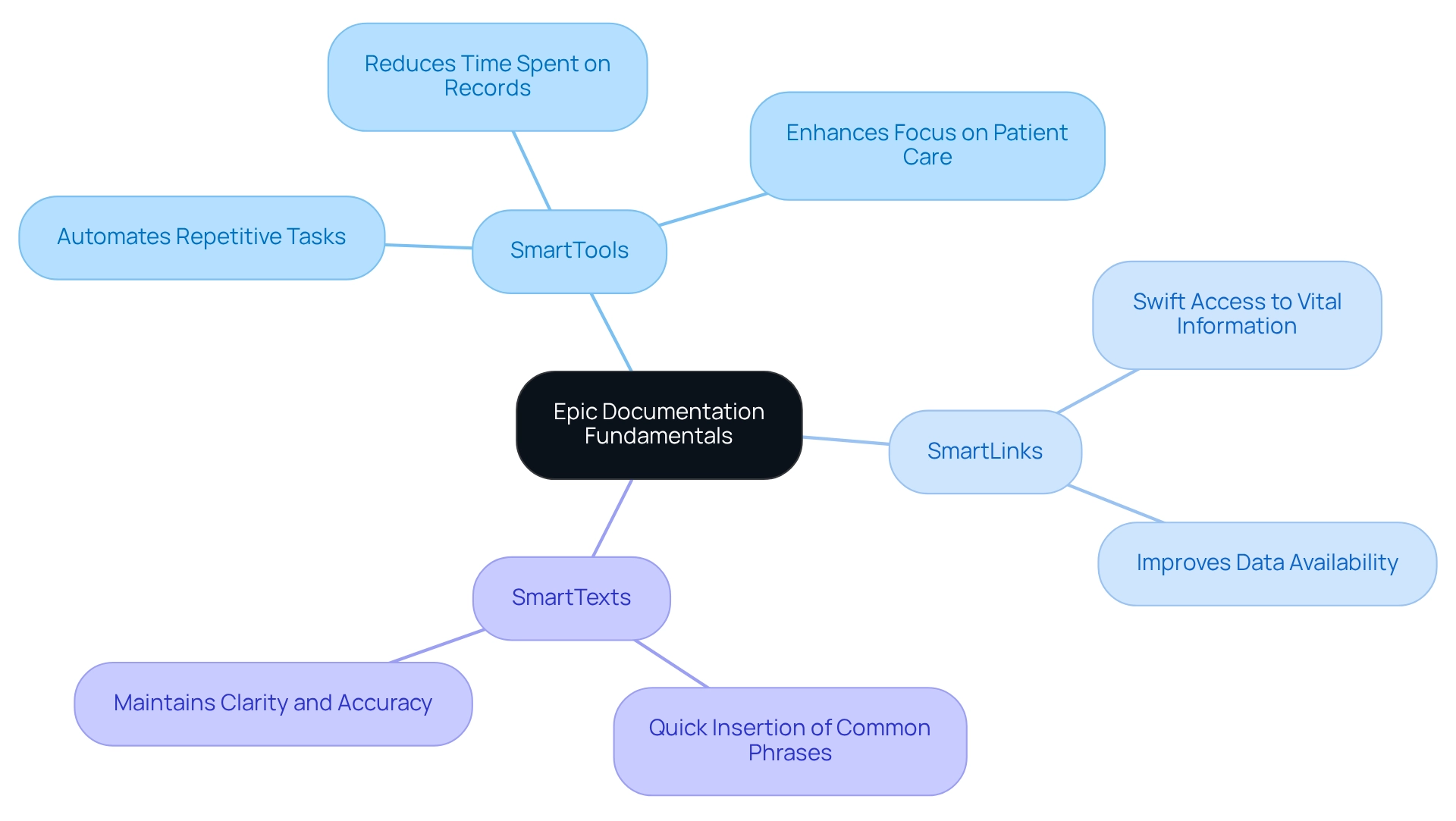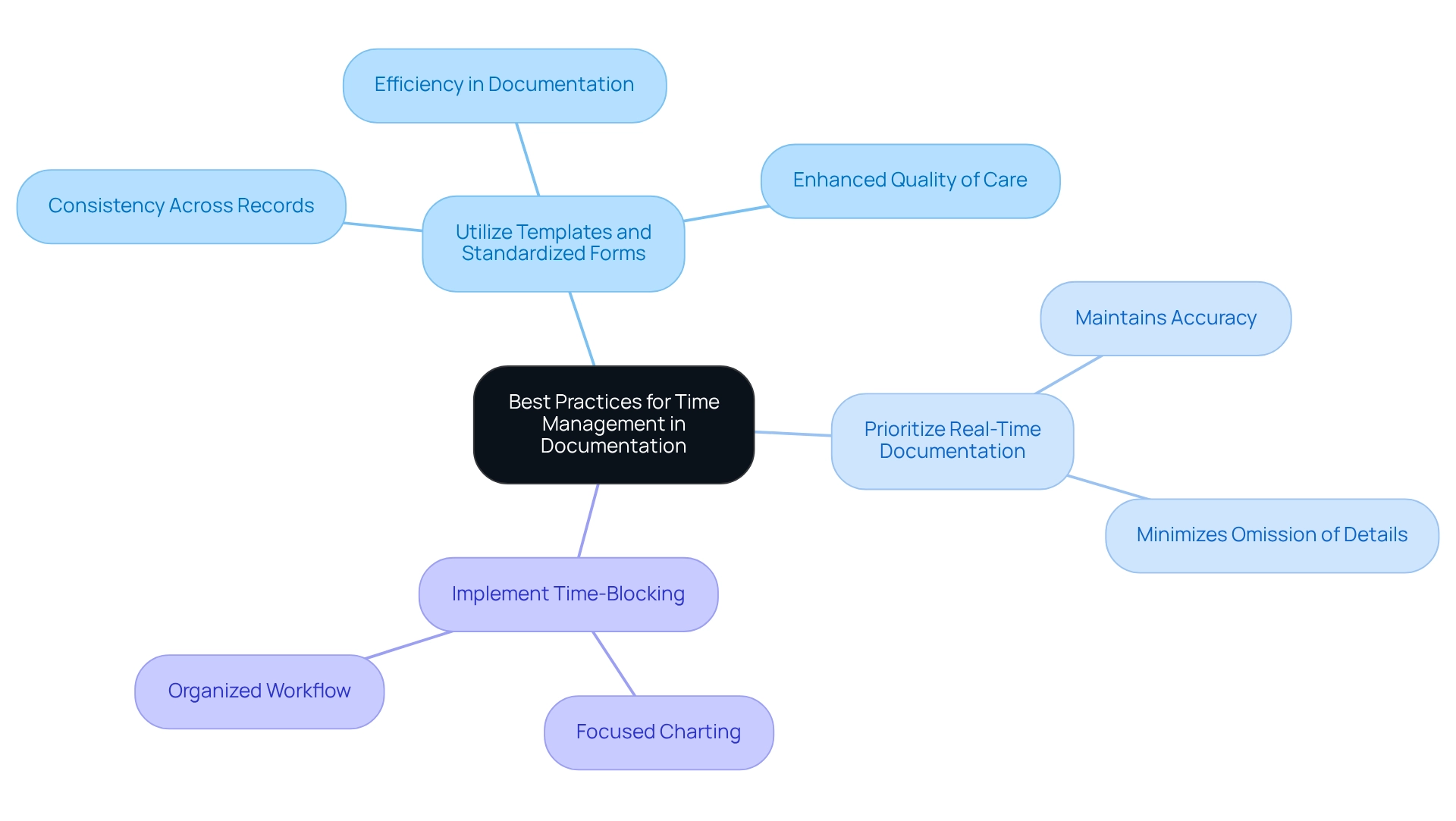Overview
In the demanding world of healthcare, nurses often face emotional challenges that can weigh heavily on their ability to provide the best care. Administrative burdens can detract from the time and energy they devote to their patients, leading to frustration and burnout. To address these concerns, the article outlines four key strategies for achieving effective Epic documentation, which can significantly alleviate these pressures.
By emphasizing the use of SmartTools, comprehensive training, AI technology, and best practices for time management, these strategies not only enhance record-keeping efficiency but also improve accuracy. Imagine a work environment where nurses can dedicate more time to patient care, feeling empowered rather than overwhelmed. This has been demonstrated through the successful implementation of tools and training programs that have transformed documentation practices in various healthcare settings.
As we explore these solutions, consider how they could impact your daily routine. How much more fulfilling would your work be if you could focus more on your patients? The benefits are clear: improved documentation leads to better patient outcomes and a more satisfying work experience.
We encourage you to engage with these strategies and reflect on how they can be integrated into your practice. Together, we can create a supportive environment that prioritizes both the well-being of healthcare providers and the quality of patient care.
Introduction
In the rapidly evolving landscape of healthcare, the emotional toll of effective documentation weighs heavily on providers. How often do you feel overwhelmed by administrative tasks that take precious time away from patient care? Epic documentation, a sophisticated electronic health record (EHR) system, is here to help. It offers innovative tools designed to streamline workflows, allowing you to focus more on what truly matters—your patients.
By mastering features like SmartTools and SmartLinks, nurses can significantly enhance their efficiency and accuracy. Imagine being able to provide better care without the constant worry of paperwork piling up. However, the journey doesn’t stop at initial training. Ongoing education and the integration of advanced technologies, such as AI, are essential for maximizing the benefits of this system.
As healthcare organizations strive to implement best practices for documentation, let’s foster a culture of continuous improvement together. This ensures that you can prioritize patient care without being bogged down by administrative burdens. Together, we can create a supportive environment where your dedication to patients shines through.
Understand Epic Documentation Fundamentals
Epic Records embodies (EHR) system that plays a crucial role in streamlining the record-keeping workflow for healthcare providers. Many nurses face emotional challenges in managing administrative tasks, which can detract from their primary focus—patient care. By becoming proficient with essential features such as SmartTools and SmartLinks, they can alleviate some of these burdens, which are crucial for achieving epic documentation for nurses:
- SmartTools: These tools automate repetitive tasks, significantly reducing the time spent on records and allowing nurses to devote more attention to their patients.
- SmartLinks: They enable swift access to vital information about individuals receiving care, ensuring that nurses have the data they need at their fingertips.
Mastering these tools not only enhances accuracy and efficiency in record-keeping but is also essential for delivering high-quality care. For example, SmartTexts allow nurses to quickly insert commonly used phrases, simplifying the record-keeping process while maintaining clarity and accuracy in patient files. As we look towards 2025, the incorporation of these functionalities in epic documentation for nurses is increasingly recognized as best practice in nursing records, emphasizing their importance in improving overall healthcare delivery.
By embracing these innovative tools, nurses can reclaim valuable time and focus on what truly matters—the well-being of their patients. How might your experience change if you could streamline your record-keeping process? Consider exploring these features to enhance your practice and the care you provide.

Prioritize Comprehensive Training and Continuous Education
To fully harness the benefits of Epic records, healthcare organizations must prioritize epic documentation for nurses through comprehensive educational programs. This includes not only initial training sessions that introduce the fundamentals of the EHR system but also ongoing education to adapt to updates and new features.
Have you considered how regular workshops or online courses focused on advanced record-keeping methods and shortcuts could enhance healthcare professionals' skills? Continuous education has been shown to boost nurses' confidence in utilizing the system, fostering a culture of excellence in patient care, and leading to epic documentation for nurses, as evidenced by at St. Joseph’s University Medical Center that revealed documentation improved in multiple areas by as much as 100%.
Moreover, KLAS Research underscores the importance of providing clinicians with 3-5 hours of continuous EHR education each year. Yet, many organizations face challenges in driving engagement with ongoing Epic education. Innovative skill development delivery methods, such as in-app instruction, can enhance engagement and assist users effectively while they work.
Well-prepared healthcare professionals are more likely to generate precise and prompt records, which is crucial for ensuring safety and upholding legal standards. By investing in robust training strategies, healthcare organizations can ensure epic documentation for nurses, which enhances record accuracy and ultimately improves patient outcomes. Together, let’s create an environment where healthcare providers feel supported and empowered to deliver the best care possible.

Leverage AI and Technology for Enhanced Documentation Efficiency
Healthcare professionals often grapple with the emotional weight of managing extensive record-keeping tasks, which underscores the importance of epic documentation for nurses. Incorporating AI tools into this process can offer a compassionate solution, significantly transforming how they manage their responsibilities.
For example, AI-driven voice recognition software effectively converts verbal notes into organized records, saving precious time and reducing the likelihood of errors. Features like predictive text and automated coding suggestions further enhance this efficiency, and by embracing these advanced technologies, nurses can utilize epic documentation for nurses to significantly lessen the time spent on record-keeping, allowing them to concentrate more on providing care to individuals.
Imagine the relief physicians could feel as they alleviate the burden of time-consuming administrative tasks, streamlining processes such as appointment scheduling, , and billing. This shift not only improves workflow but also enriches the overall quality of care delivered to individuals.
As we consider the emotional challenges faced in healthcare, it becomes clear that can make a meaningful difference. Let’s engage with these tools and explore how they can support you in your vital work.
Implement Best Practices for Time Management in Documentation
Improving time management in nursing records can feel overwhelming, but adopting best practices can make a significant difference. By utilizing templates and standardized forms, the process of creating epic documentation for nurses becomes more efficient, reducing time spent on repetitive tasks and ensuring consistency across records. A study observing nursing activities highlights that structured templates not only streamline the process but also enhance the quality of care provided by physicians. This reinforces the importance of such approaches in our daily practice.
Have you considered the impact of real-time documentation? Entering information immediately after patient interactions helps maintain accuracy and minimizes the risk of omitting critical details. Implementing a structured method, like time-blocking specific periods for charting, can empower healthcare professionals to stay organized and focused. A case study on the long-term effects of EMR template usage in pediatric orthopaedics revealed prompt improvements in record-keeping practices. However, further research is needed to evaluate the sustainability of these enhancements.
By embracing these strategies, healthcare professionals can enhance their efficiency while ensuring that patient care remains the top priority. As one nurse insightfully noted, "this work can aid nursing leaders in formulating strategies for transforming nursing practice," underscoring the significance of organized record-keeping methods. Moreover, developed by a multidisciplinary task force can improve epic documentation for nurses, enhance clinical documentation quality, and facilitate communication among providers, ultimately benefiting patient care.
Key Solutions to Consider:
- Utilize templates and standardized forms for consistency.
- Prioritize real-time documentation to maintain accuracy.
- Implement time-blocking for focused charting.
By taking these steps, we can nurture a more efficient and compassionate healthcare environment.

Conclusion
The integration of Epic documentation into healthcare practices represents a significant shift that fundamentally enhances the efficiency and accuracy of nursing documentation. Have you ever felt overwhelmed by the demands of paperwork? By mastering essential features like SmartTools and SmartLinks, nurses can automate repetitive tasks and swiftly access critical patient information, creating a more streamlined workflow. This not only saves valuable time but also contributes to delivering high-quality patient care.
Comprehensive training and continuous education are vital for maximizing the potential of Epic documentation. Organizations must invest in robust training programs that encompass both initial education and ongoing skill development. By fostering a culture of continuous improvement, healthcare providers can ensure that nurses feel confident and proficient in utilizing the EHR system, ultimately leading to better documentation practices and improved patient outcomes.
Moreover, leveraging advanced technologies, including AI tools, can further enhance the documentation process. Imagine a scenario where tasks such as transcription and coding are automated, allowing nurses to focus more on patient care rather than administrative burdens. Implementing best practices for time management, such as using structured templates and real-time documentation, also plays a crucial role in maintaining accuracy and efficiency.
In summary, embracing Epic documentation and its associated technologies alleviates the administrative strain on healthcare providers and prioritizes patient care. By fostering an environment of ongoing education and adopting best practices, healthcare organizations can empower nurses to excel in their roles, ensuring that patient care remains the central focus. Together, these efforts contribute to a more effective and compassionate healthcare system.




